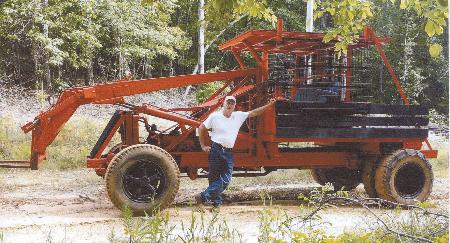Big Loader Tractor Built From Schoolbus

"It really comes in handy around our farm and saves a lot of wear and tear on our other tractors and pickups," says Mississippi farmer Jerry Coleman, of Belmont, about the big loader tractor he built out of an old 65-passenger schoolbus. The loader is equipped with a set of forks that can be converted to a "grabber" fork. It lifts loads up to 20 ft. high.
The tractor uses the bus's original wheels and axles and has no hood or cab. The boom was built from 2 by 6-in. square tubing and bolts onto a steel frame located just ahead of the driver. Coleman used steel scaffolding to build a 6-ft. wide by 7-ft. long canopy above the driver's seat. He installed a large floor made out of 4 by 21-in. white oak and mounted wooden sideboards on both sides of it to form a box to haul cargo. He also added a ball hitch on back.
The boom, which he welded between the wheels of the frame, has a 20-ft. forward and vertical reach and is powered by a 42 gpm hydraulic pump driven by the bus's crankshaft. He uses the bus's original power steering pump to provide hydraulic steering.
"It drives more like a car than a tractor," says Coleman. "I built it because I own a small farm and also operate a commercial junkyard. I wanted a tractor that could stack round bales up to 5 high in order to use all the space inside my barn. In the field, I load the bales onto a 16-ft. long trailer and haul them to the barn. I then use the loader to raise one end of the trailer until all the bales roll off, and then I stack them.
"I also use the loader to pick up junked cars and stack them 3 or 4 high on our farm so they can later be hauled to a crushing facility. I built the tractor mostly out of scrap steel and other parts that I already had, so if anything ever goes wrong I can always find replacement parts."
He also uses the loader with a home-built, fork-mounted blade that works like an axe to cut off tree limbs as the loader is raised. Both ends of the blade are held in place by lengths of square tubing. "The pressure of the loader pushing upward cuts the limbs off," says Coleman.
He got the 1990 Chevrolet bus at an auction and paid $550 for it. He stripped the bus down to the frame and shortened the wheelbase to 150 in. He replaced the original engine with a 454 cu. in. Chevrolet engine, moving the engine back 20 in. to balance the load.
The bus has 2 transmissions ? the Chevy car's automatic transmission and a standard 3-speed transmission - in order to gear it down. Coleman cut the center out of the bus's clutch and made a short driveshaft to connect the 2 transmissions. He ended up with 12 forward gears and 6 reverse.
"It has a lot of power in low gear. If I put both transmissions in low gear and open up the throttle the tractor will barely move," says Coleman. "The 2 transmissions work somewhat like the shuttle shift transmissions found on modern tractors. It works great when scooping gravel because the tires barely spin and don't tear up the ground."
He mounted a hydraulic reservoir and a pair of hydraulic valves and controls next to the driver's seat. The seat and steering wheel sets off to one side so he has a good view of the loader. The 20-gal. gas tank is off an old boat. The steering wheel is original, but Coleman used pipe and bearings to lengthen the steering column. The bench seat is off an old cargo van.
There are 5 hydraulic cylinders on the boom " 2 for lifting, 2 for tilting the bale fork, and one for rotating the grapple fork.
The canopy's roof doubles as a scaffold and has built-in supports to accept more scaffolding on top. "I can pull up alongside a barn and work up high to paint or do repair work," says Coleman.
A heavy-duty panel made from steel wire shelving protects the radiator from anything that might fall out of the loader bucket. The steps are off an old Massey Ferguson combine.
